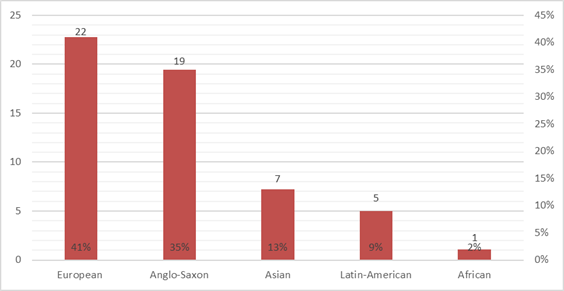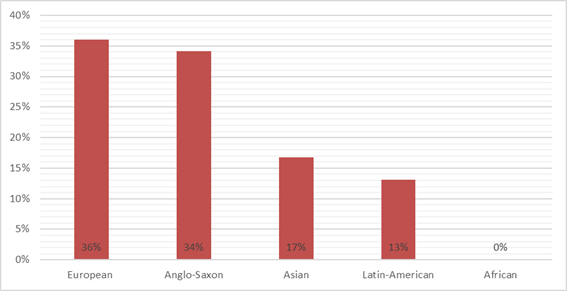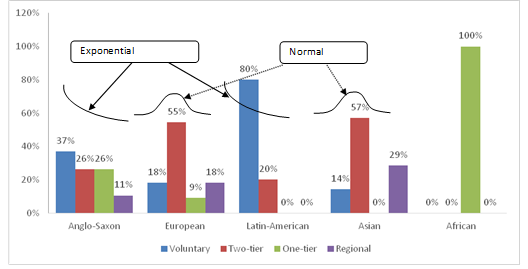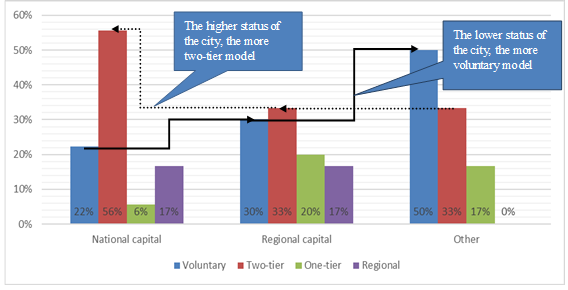Abstract
Metropolitan areas are the main economic base of most modern States. The concentration of population and production capacity in agglomerations is the platform for getting agglomeration effect. One of the most important issues that is necessary to resolve is the choosing of the metropolitan governance model. It is necessary to answer: “Who manages?”, “What is managed?”, “How it should be managed?”. There are many different metropolitan governance models that can be combined into four groups (listed in increasing order of centralization): voluntary, two-tier, one-tier, regional. The purpose of the study is to identify the link between metropolitan governance models and institutional factors: civilizational features of the host countries, the status of the central city of agglomeration. The sample, represented by 54 metropolitan areas from 29 States of the world, was used as a research object. It was identified that, with a probability of 90%, civilizational features of the host countries of agglomerations influence the selection of metropolitan governance models. Less centralized models (voluntary group) prevail in the Anglo-Saxon and Latin American countries, medium-centralized models (two-tier group) – in the European and Asian countries. According to the statistical survey, the status of the central city of the agglomeration (a center, a regional center, a subordinated city) does not have significant impact (with a probability of 51,1%) on the selection of the management model. However, with the help of the graphic distribution construction, we have identified the following logical connections: the higher the status of agglomeration is the more centralized model is used.
Keywords: Metropolitan governance modelurban agglomerationmetropolitan areacivilizational features of countriesthe status of the central city
Introduction
There are about a few hundred large agglomerations and thousands of small agglomerations in the world. But, regardless of the size, every agglomeration has a unique management model.
We have found several works on the identification of recurrent dependencies between civilizational, ethnic cultural particularities of the countries – territories of locations, States’ legal regimes and metropolitan governance models. Lefèvre was one of the first sociologists who had suggested the existence of such dependencies specifically for urban agglomerations (Lefèvre, 2008).
Blair A. Ruble classifies these dependencies in the following way (Ruble, 2013):
State-centralized model, where the main role is played by public administration (common in Asian countries);
Fragmented / sectoral state model (more common in EU countries; a two-tier model (EU, UK – London);
Public-private cooperation model (USA), one-tier consolidated model (USA, Canada-Toronto).
The dependence of the selection of the metropolitan governance model on the regime, the degree of the governmental centralization was not identified (Clark & Moonen, 2014).
The fundamental global study of OECD on metropolitan areas was conducted in 2014 (OECD, 2014). 275 agglomerations were investigated. As a result, the agglomeration model particularities were revealed for 21 (out of 27) countries. What is more, the tendencies of the metropolitan area center and outskirts development for each state were revealed too (Veneri, 2015). However, the grouping of all investigated agglomerations by the main (abstracted) management model groups was not done. Therefore, it is expedient to realize this phase of the study.
Problem Statement
It is necessary to identify the dependencies between used metropolitan governance model and institutional factors: the civilizational particularities of the countries – territories of location (according to the affiliation of the country of the agglomeration location to one or another civilizational group), the status of the central city of the agglomeration. In a successful attempt to identify statistical dependence it can be argued that both quantitative social-economic factors, describing the development level of the agglomeration, and institutional factors, reflecting civilizational or national and cultural particularities of countries – territories of agglomeration location, influence the selection of management models. In this case it will be as a justification to greater attention to the consideration of civilizational particularities; provide an approximate idea of which management model is potentially more suitable for implementation in one or other country. At the same time, it is necessary to understand that the identified dependencies are not functional, i.e. it identifies the selection of the management model not 100%.
Research Questions
In the study we tried to answer the following questions:
Do the civilizational, ethnic-cultural particularities of the countries where agglomerations are located influence the selection of the metropolitan governance model?
Does the status of the central city of the agglomeration influence the selection of the metropolitan governance model?
Purpose of the Study
The purposes of the study:
To justify statistically the non-randomness of the management model distribution within institutional groups.
To identify logical pattern between metropolitan governance model distribution and influencing factors: institutional particularities and the status of the central city of the agglomeration.
Research Methods
Because of the lack of the necessary information, it is impossible to analyze used management models of each agglomeration. That is why, the presence of reliable sources of information (in scientific publications, on official websites) about models of agglomeration management served as a filter. This allowed to avoid subjectivity in determining the type of the management model.
In different countries metropolitan areas are understood as objects that sometimes differ in a number of nuances because of using different delimitation methods (Parilla, Trujillo, Berube, & Ran, 2015; Pavlov & Koroleva, 2017). In this study we understand metropolitan areas (or urban agglomerations) as a set of territories of compactly located settlements, mainly urban ones, that are united in a complex dynamic developing system with intensive production, infrastructural, social and economic links, common use of adjacent areas and development resources.
Input data
The sample of metropolitan areas, that use various management models, was compiled. The sample was compiled on the basis of primary studies of Russian, French, Spanish, American scientists, etc.: OECD (OECD, 2014), Andersson M. (Andersson, Verena, & Fabienne, 2015), Popov R.A. (Popov, 2015), studies by the consulting firm Strategy Partners Group (2014).
Different researchers included the same agglomeration in different groups according to the compiled management models. That is why, there were some difficulties with the identification agglomeration model.
New York city was taken as an example. Enid Slack and André Côté refer this city to the group with one-tier management model (Slack & Côté, 2014); Andersson M. – with a voluntary model (Andersson et al., 2015); JSC “Russian Institute for Urban Development and Investment Development “GIPROGOR”- with a voluntary model (Analytical statement, 2013).
Besides New York, Berlin, Los Angeles and Paris also belong to three different groups of the management models. Barcelona, Bremen, Vancouver, Hamburg, Madrid, Montreal, Mumbai, Seoul, Sydney, Shanghai belong to two groups.
None of the researchers provided an assessment of management models for all 54 metropolitan areas. Therefore, the sample is based on several studies. What model should be chosen if there are contradictions between experts? We decided to take, as the main model, one that is identified by the most authoritative sources, or if there is the consensus between several scientists (Table
Assumptions and disclaimers
A number of assumptions was made during the study.
There is no net metropolitan governance model. One model can involve, more or less, elements of other models. Therefore, the allocation of the models as separate categories is an abstraction (i.e. reality corresponds partly).
The authors tried to find a number of statistical patterns of the distribution of management models among agglomerations under the impact of certain factors. Thus, the empirical law that was derived through the use of induction will have the character of a probabilistic-statistical one.
The human factor is not taken into account, namely, political abilities of local leaders that sometimes has a decisive impact on the selection of the metropolitan governance model. The human factor can be referred to the “tails” of the distribution.
The authors assume that a sample, consisting at least 30 agglomerations with a population over 1 million people in each country that represents different civilizational groups (e.g. the USA, Germany, China, Mexico, South Africa), statistically would be more reliable. But at the moment, management models of these agglomerations are, mostly, poorly studied.
Kinds of management models
There are a lot of metropolitan governance models, there is no commonly used classification. Authoritative scientist Slack proposes the following models (Slack, 2014):
1)One-tier fragmented government structures;
2)One-tier consolidated government structures;
3)Two-tier government model;
4)City-state;
5)Voluntary cooperation/special purpose districts.
It is clarified that the agglomeration can combine more than one model, and each model reflects place and time specifics, it is not “the best one” for all time.
Taking into account plenty of models’ modifications, we suggest to group models into summarizing groups: a “voluntary model” (only inter-municipal cooperation), a “two-tier model” (creating a new administrative entity with municipal upper level without abolishing old municipalities), “one-tier model” (municipal model with one governance body), “regional model” (a two-tier model with an upper level as a regional government that receives certain powers from municipalities, or city-state/urbanized region).
Models can be distributed according to the degree of powers’ centralization (Tomas, 2015). We suppose that four groups of models, we have identified, can be distributed according to the degree of centralization in the following way (assigned % are an approximate estimate that was given by the authors) (Figure

Findings
The objects’ sample
54 agglomerations were considered. There is information that contains the management model description (Table
The agglomeration distribution according to the groups of the countries
According to the civilizational particularities of the country, locations of all agglomerations can be divided into five groups (Fig.02).

Anglo-Saxon and European agglomerations are 76% of the sample, other agglomerations – 24%. It is understandable because the research of agglomerations was started in Europe and North America.
At the same time, this statistic is very close (according to the obtained proportions) to the OECD sample, that was conducted during the research of metropolitan areas (OECD, 2014) (Figure

The part of the Anglo-Saxon group in our sample is 1% more than in OECD one; the part of the European group is 5% more. The share of the Asian group is 4% less than OECD one, the share of the Latin-American group is 4% less. The African group was not considered at all.
Consequently, the sample of our research has much in common with the OECD sample. This demonstrates that the sample is credible.
Dependence of the metropolitan governance model on civilizational features
The frequency of the occurrence of the management models according to the whole sample is shown in Table
Most often there is a two-tier management model in the sample (22, or 41% of cases); rarer (16, or 29% of cases) – a voluntary model. One-tier and regional models are quite rare (8, or 15% of cases).
However, national-cultural features influence the distribution within groups.
The frequency of the occurrence of different models according to the groups is shown in Figure

The two-tier model is more typical for the European and Asian groups (55% and 57%).
The voluntary model is more common in the Anglo-Saxon and Latin-American groups (37% and 80%); on average – 29% (round the world).
The one-tier group is rare. It is more common in the Anglo-Saxon practice (26%), than in the European one (9%).
The regional model is also rare. It is more common in the Asian practice (29%), rarer – in the European one (18%), and very seldom – in the Anglo-Saxon practice (11%).
The predominance of the less centralized models over the more centralized models is typical for the Anglo-Saxon countries. In fact, we have received the similarity of the exponential distribution.
The medium degree of centralization is typical for the European group, i.e. the semblance of the normal distribution, but with outliers in the form of increasing significance of the regional model.
Less centralized models are more important for the Latin-American group, that corresponds to the exponential distribution, but the smooth degree is much less than in the Anglo-Saxon countries.
The semblance of the normal distribution is typical for the Asian group of countries, but the predominance of the share of the most centralized management model is higher than in the European group.
Using the “X2 test” method, we show that the dependencies received are not random. The “X2 test” criterion gives a rough estimate. To improve the accuracy of the assessment, you can increase the sample. The actual distribution of the management models within the institutional groups of countries is shown in Table
The number of freedom degrees is calculated as: (5-1)*(4-1)=12. Х2critical for the significance level of 0.1 is 18.55; Х2test is 20,88. Х2test>Х2critical, consequently, with probability of 90% it can be argued, that institutional factors influence the predominance of one or another metropolitan governance model in the institutional group of countries.
The Excel function “CHITEST” has given us a value of 0.052. This means that the thesis on the independence of institutional factors and the selection of management model can be taken with the significance level of 5.2%. But with the probability of 94.8% this hypothesis is erroneous.
Thus, we have substantiated that institutional factors influence the distribution of metropolitan governance models.
Dependence of the management model on the status of the central city of the agglomeration
According to the administrative status, the models of agglomerations, formed around the national capital (30 cases), regional capital (18 cases) or other (6 cases), are studied most often. Thus, agglomerations, whose centers are not the capitals of the states or regions (e.g. New York or Chicago) are studied very rarely. It is interesting that among the agglomerations with the centers in subordinated cities, 100% belong to the Anglo-Saxon practice of managing agglomerations.
Our sample, as such, differs from the OECD sample, out of 275 cases, only 27 – capitals.
The distribution of the metropolitan governance models according to the administrative status is shown in Figure

According to the demonstrated data in Figure
The verification of the distribution randomness with the help of the “X2 test” method demonstrated that the hypothesis about the influence of the urban agglomeration status on the management model is erroneous with the probability of 51.1%. This conclusion contradicts the logic, that is why we assume that as data accumulate and the sample is expanded, the dependence can be confirmed statistically.
Conclusion
The influence of the factors
Civilizational particularities of the countries, where agglomerations are located, affect the frequency of using one or other management model. This hypothesis was confirmed with the probability of 90% with the help of the “X2 test” method.
The status of the central city of the metropolitan area affects the selection of the management model. The high status of the central city presupposes the importance of its accountability to the leadership of the state (region). That is why, both the degree of centralization of the metropolitan governance model and the significance of the status of the central city grow. However, this hypothesis was not confirmed by the use of the “X2 test” method. From our point of view, the sample increase allows to confirm this hypothesis statistically in the future.
Patterns between the distribution of the management models and civilizational groups
The predominance of less centralized models over the more centralized ones, that gives the semblance of the exponential distribution, is typical for the Anglo-Saxon countries.
The average degree of centralization, i.e. the semblance of the normal distribution with emissions in the form of the significance increase of the regional model, is typical for the European group.
Less centralized model is typical for the Latin-American group. It forms the semblance of the exponential distribution, but its smooth level is much less than in the Anglo-Saxon countries.
The semblance of the normal distribution conforms to the Asian group, however, the predominance of the most centralized management model is higher than in the European group (the presence of the thicker legal “tail” of the distribution).
The ideas, that we propose, should be developed through the further increase of the sample in order to increase the accuracy of the statistical justification of the identified patterns.
Acknowledgments
This study wishes to acknowledge the support given by Samara state university of economics, which creates good conditions for our research.
References
- Analytical statement. (2013). Development of metropolitan areas: analytical review. №2. Russia: public corporation "Russian Institute of Urban Development and Investment "Giprogor". Retrieved from URL: http://www.giprogor.ru/analytics/publications.
- Andersson, M., Verena, M., & Fabienne, P. (2015). Unpacking Metropolitan Governance for Sustainable Development. Bonn, Germany: GIZ (Deutsche Gesellschaft für Internationale Zusammenarbeit GmbH). Retrieved from URL: https://unhabitat.org/books/unpacking-metropolitan-governance-for-sustainable-development/.
- Clark, G., & Moonen, T. (2014). Global cities and nation states: a new course for the partnership in the 21st century. Moscow, Russia: Moscow Urban Forum. Retrieved from URL: http://mosurbanforum.ru/files/pdf/analiticheskie_obzory/ru_small.pdf.
- Lefèvre, C. (2008). Democratic Governability of Metropolitan Areas: International Experiences and Lessons for Latin American Cities. In Rojas E., Cuadrado-Roura J. R., Guell J. M. F. (Eds.), Governing the metropolis: principles and cases (p.137-192). Washington: Inter-American Development Bank. Retrieved from URL: https://publications.iadb.org/bitstream/handle/11319/445/Governing%20the%20Metropolis.pdf?sequence=1.
- OECD (2014). OECD Regional Outlook 2014: Regions and Cities: Where Policies and People Meet, OECD Publishing, Paris.
- Parilla, P., Trujillo, J.L., Berube, A., & Ran, T. (2015). Global Metro monitor an uncertain recovery 2014. Washington: Metropolitan policy program. Retrieved from URL: http://washcouncil.org/presentations-2015/2014-Global-Metro-Monitor-Map.pdf.
- Pavlov, Y.V., & Koroleva, E.N. (2017). Sources and results of knowledge generation about the Samara-Togliatti agglomeration. Vestnik of Samara State University of Economics, 5 (151), 19-28. Retrieved from URL: http://vestnik.sseu.ru/index.php?cnt=1&idv=310.
- Popov, R.A. (2015). New trends in the management of the development of urban centers in Russia. Moscow: The Institute for Urban Economics. Retrieved from URL: http://www.urbaneconomics.ru/node/8709.
- Ruble, B. A. (2013). World experience in the era of urban agglomerations: Lessons for the control of Moscow. LOGOS, 4 (94), 267-287. Retrieved from URL: http://www.logosjournal.ru/arch/64/94_11.pdf.
- Slack, E. (2014). Governance and Finance of Large Metropolitan Areas: Which Institutional Setting is Needed to Secure Metropolitan Economic Growth? Presentation to 5th Halle Forum on Urban Economic Growth. Halle, Germany: Halle Forum on Urban Economic Growth. Retrieved from URL: http://munkschool.utoronto.ca/imfg/uploads/304/slack_presentation_on_governance_and_finance_of_metropolitan_areas_halle_december_11_2014.pdf.
- Slack, E., & Côté, A. (2014). Comparative urban governance. Future of cities: working paper. London, UK: Foresight, Government Office for Science. Retrieved from URL: https://www.gov.uk/government/uploads/system/uploads/attachment_data/file/360420/14-810-urban-governance.pdf.
- Strategy Partners Group. (2014). The main directions of development of Samara-Togliatti agglomeration. Russia: Strategy Partners Group. Retrieved from URL: http://www.samara-center.ru/on-line/f/5A2529CF-E079-4A39-9421-D61B0EFF0CC6/presentation_m.s.skvirskiy.pdf.
- Tomаs, M. (2015). Metropolitan Governance in Europe: Challenges and models. Barcelona, Spain: European Metropolitan Authorities. Retrieved from URL: https://www.researchgate.net/publication/273759034_Metropolitan_Governance_in_Europe_Challenges_Models (free access).
- Veneri, P. (2015), “Urban Spatial Structure in OECD Cities: is Urban Population Decentralising or Clustering?”, OECD Regional Development Working Papers, 2015/01, Paris: OECD Publishing.
Copyright information

This work is licensed under a Creative Commons Attribution-NonCommercial-NoDerivatives 4.0 International License.
About this article
Publication Date
20 March 2019
Article Doi
eBook ISBN
978-1-80296-056-3
Publisher
Future Academy
Volume
57
Print ISBN (optional)
-
Edition Number
1st Edition
Pages
1-1887
Subjects
Business, business ethics, social responsibility, innovation, ethical issues, scientific developments, technological developments
Cite this article as:
Pavlov, Y., & Koroleva, E. (2019). Influence Of Institutional Factors On The Selection Of The Metropolitan Governance Model. In V. Mantulenko (Ed.), Global Challenges and Prospects of the Modern Economic Development, vol 57. European Proceedings of Social and Behavioural Sciences (pp. 1277-1288). Future Academy. https://doi.org/10.15405/epsbs.2019.03.130

